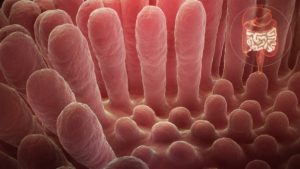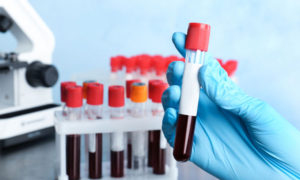Bay Biosciences provides high quality, clinical grade peripheral blood mononuclear cells (PBMC) biofluid samples(PBMC) samples from untreated patients newly diagnosed with Celiac Disease. Samples are processed under customized protocols provided by the researcher.

Celiac Disease Overview
Celiac disease is an autoimmune condition that occurs in genetically predisposed patients where the ingestion of gluten leads to damage in the small intestine. Celiac disease, sometimes called celiac sprue or gluten-sensitive enteropathy, is an immune reaction to eating gluten, a protein found in wheat, barley and rye. Celiac disease is estimated to affect 1 in 100 people worldwide.
In Celiac disease patients, eating gluten triggers an immune response in the small intestine. Over time, this reaction damages the small intestine’s lining and prevents it from absorbing some nutrients (malabsorption). These attacks lead to damage on the villi, small fingerlike projections that line the small intestine, that promote nutrient absorption. When the villi get damaged, nutrients cannot be absorbed properly into the body. The intestinal damage often causes diarrhea, fatigue, weight loss, bloating and anemia, and can lead to serious health complications.
Celiac disease is an inherited disorder, which means that it runs in families. People with a first-degree relative with celiac disease (parent, child, sibling) have a 1 in 10 risk of developing celiac disease. Celiac disease can develop at any age after people start eating foods or medicines that contain gluten. Left untreated, celiac disease can lead to additional serious health problems. In children, malabsorption can affect growth and development, besides causing the symptoms seen in adults. There’s no cure for celiac disease, but for most patients, following a strict gluten-free diet can help manage symptoms and promote intestinal healing.

Signs and Symptoms of Celiac Disease
The signs and symptoms of Celiac disease can vary greatly and differ in children and adults.
Digestive signs and symptoms for adults include:
- Diarrhea
- Fatigue
- Weight loss
- Bloating and gas
- Abdominal pain
- Nausea and vomiting
- Constipation
However, more than half the adults with Celiac disease have signs and symptoms unrelated to the digestive system, including:
- Anemia, usually from iron deficiency
- Loss of bone density (osteoporosis) or softening of bone (osteomalacia)
- Itchy, blistery skin rash (dermatitis herpetiformis)
- Mouth ulcers
- Headaches and fatigue
- Nervous system injury, including numbness and tingling in the feet and hands, possible problems with balance, and cognitive impairment
- Joint pain
- Reduced functioning of the spleen (hyposplenism)

Celiac Disease in Children
Children with celiac disease are more likely than adults to have digestive problems, including:
- Nausea and vomiting
- Chronic diarrhea
- Swollen belly
- Constipation
- Gas
- Pale, foul-smelling stools
The inability to absorb nutrients might result in:
- Failure to thrive for infants
- Damage to tooth enamel
- Weight loss
- Anemia
- Irritability
- Short stature
- Delayed puberty
- Neurological symptoms, including attention-deficit/hyperactivity disorder (ADHD), learning disabilities, headaches, lack of muscle coordination and seizures
Celiac Disease Related Dermatitis Herpetiformis
Gluten intolerance can cause this itchy, blistering skin disease known as dermatitis herpetiformis. The rash usually occurs on the elbows, knees, torso, scalp and buttocks. This condition is often associated with changes to the lining of the small intestine identical to those of celiac disease, but the skin condition might not cause digestive symptoms.

Causes of Celiac Disease
Patients genes combined with eating foods with gluten and other factors can contribute to developing celiac disease, but the precise cause isn’t known. Infant-feeding practices, gastrointestinal infections and gut bacteria might contribute, as well. Sometimes celiac disease becomes active after surgery, pregnancy, childbirth, viral infections or severe emotional stress. When the body’s immune system overreacts to gluten in food, the reaction damages the tiny, hair like projections (Villi) that line the small intestine. Villi absorb vitamins, minerals and other nutrients from the food you eat. If the villi are damaged, patients can’t get enough nutrients, no matter how much they eat.
Celiac Disease Risk Factors
Celiac disease tends to be more common in patients who have:
- A family member with celiac disease or dermatitis herpetiformis
- Type 1 diabetes
- Down syndrome or Turner syndrome
- Autoimmune thyroid disease
- Microscopic colitis (lymphocytic or collagenous colitis)
- Addison’s disease
Celiac Disease Complications
Untreated, Celiac disease can cause the following complications:
- Malnutrition- This symptom occurs if the small intestine can’t absorb enough nutrients. Malnutrition can lead to anemia and weight loss. In children, malnutrition can cause slow growth and short stature.
- Bone weakening- Malabsorption of calcium and vitamin D can lead to a softening of the bone (osteomalacia or rickets) in children and a loss of bone density (osteopenia or osteoporosis) in adults.
- Infertility and miscarriage- Malabsorption of calcium and vitamin D can contribute to reproductive problems.
- Lactose intolerance- Damage to the small intestine might cause abdominal pain and diarrhea after eating or drinking dairy products that contain lactose. Once the intestine has healed, patients might be able to tolerate dairy products again.
- Cancer– Patients with Celiac disease who don’t maintain a gluten-free diet have a greater risk of developing several forms of cancer, including intestinal lymphoma and small bowel cancer.
- Nervous system problems- Some patients with Celiac disease can develop problems such as seizures or a disease of the nerves to the hands and feet (peripheral neuropathy).

Nonresponsive Celiac Disease Patients
Some patients with Celiac disease don’t respond to what they consider to be a gluten-free diet. Nonresponsive celiac disease is often due to contamination of the diet with gluten.
Patients with nonresponsive Celiac disease might have:
- Bacteria in the small intestine (bacterial overgrowth)
- Microscopic colitis
- Poor pancreas function (pancreatic insufficiency)
- Irritable Bowel Syndrome
- Difficulty digesting sugar found in dairy products (lactose), table sugar (sucrose), or a type of sugar found in honey and fruits (fructose)
- Refractory celiac disease
Refractory Celiac Disease
In rare instances, the intestinal injury of Celiac disease doesn’t respond to a strict gluten-free diet. This is known as refractory celiac disease. If the Celiac disease patients still have signs and symptoms after following a gluten-free diet for six months to one year, they might need further testing to look for other explanations for their symptoms.
Celiac Disease Diagnosis
Many patients with Celiac disease don’t know they have it. Two blood tests can help diagnose it:
- Serology testing looks for antibodies in the blood. Elevated levels of certain antibody proteins indicate an immune reaction to gluten.
- Genetic testing for human leukocyte antigens (HLA-DQ2 and HLA-DQ8) can be used to rule out celiac disease.
It’s important to be tested for Celiac disease before prescribing a gluten-free diet. Eliminating gluten from the diet might make the results of blood tests appear normal. If the results of these tests indicate Celiac disease, the doctor will likely order one of the following tests:
- Endoscopy- This test uses a long tube with a tiny camera that’s put into the mouth and passed down the throat (upper endoscopy). The camera enables the doctor to view patients small intestine and take a small tissue sample (biopsy) to analyze for damage to the villi.
- Capsule endoscopy. This test uses a tiny wireless camera to take pictures of the entire small intestine. The camera sits inside a vitamin-sized capsule, which you swallow. As the capsule travels through the digestive tract, the camera takes thousands of pictures that are transmitted to a recorder.
If dermatitis herpetiformis is suspected, a small biopsy sample of skin tissue might be taken to examine under a microscope (skin biopsy).
Bay Biosciences is a global leader in providing researchers with high quality, clinical grade, fully characterized human tissue samples, bio-specimens and human bio-fluid collections from cancer (tumor) tissue, cancer serum, cancer plasma cancer PBMC and human tissue samples from most other therapeutic areas and diseases.
Bay Biosciences maintains and manages it’s own bio-repository, human tissue bank (biobank) consisting of thousands of diseased samples (specimens) and from normal healthy donors available in all formats and types. Our biobank procures and stores fully consented, deidentified and institutional review boards (IRB) approved human tissue samples and matched controls.
All our human human tissue collections, human specimens and human bio-fluids are provided with detailed samples associated patient’s clinical data. This critical patient’s clinical data includes information relating to their past and current disease, treatment history, lifestyle choices, biomarkers and genetic information. Patient’s data is extremely valuable for researchers and is used to help identify new effective treatments (drug discovery & development) in oncology, other therapeutic areas and diseases. This clinical information is critical to demonstrate their impact, monitor the safety of medicines, testing & diagnostics, and generate new knowledge about the causes of disease and illness.
Bay Biosciences banks wide variety of human tissue samples and biological samples including cryogenically preserved -80°C, fresh, fresh frozen tissue samples, tumor tissue samples, FFPE’s, tissue slides, with matching human bio-fluids, whole blood and blood derived products such as serum, plasma and PBMC’s.
Bay Biosciences is a global leader in collecting and providing human tissue samples according to the researchers specified requirements and customized, tailor made collection protocols. Please contact us anytime to discuss your special research projects and customized human tissue sample requirements.
Bay Biosciences provides human tissue samples (human specimens) from diseased and normal healthy donors; including peripheral whole-blood, amniotic fluid, bronchoalveolar lavage fluid (BAL), sputum, pleural effusion, cerebrospinal fluid (CSF), serum (sera), plasma, peripheral blood mononuclear cells (PBMC’s), saliva, Buffy coat, urine, stool samples, aqueous humor, vitreous humor, kidney stones, renal calculi, nephrolithiasis, urolithiasis and other bodily fluids from most diseases including cancer. We can also procure most human bio-specimens and can do special collections and requests of human samples that are difficult to find. All our human tissue samples are procured through IRB approved clinical protocols and procedures.
In addition to the standard processing protocols Bay Biosciences can also provide human plasma, serum, PBMC bio-fluid samples using custom processing protocols, you can buy donor specific sample collections in higher volumes and specified sample aliquoting from us. Bay Biosciences also provides human samples from normal healthy donors, volunteers, for controls and clinical research, contact us Now.
日本のお客様は、ベイバイオサイエンスジャパンBay Biosciences Japanまたはhttp://baybiosciences-jp.com/contact/までご連絡ください。
